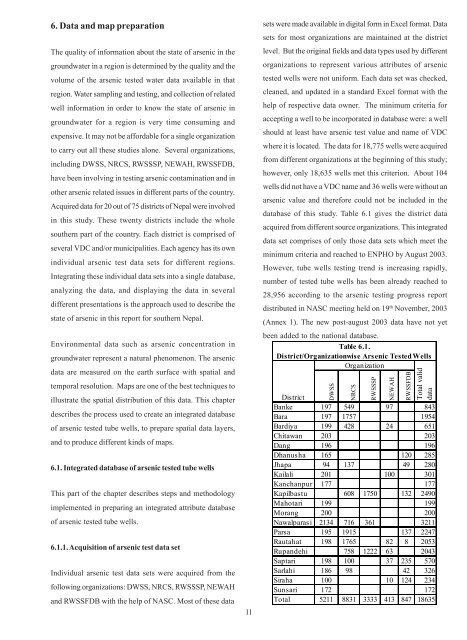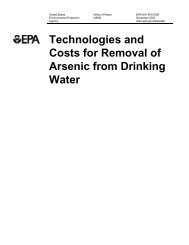The State of Arsenic in Nepal - 2003 - Harvard University ...
The State of Arsenic in Nepal - 2003 - Harvard University ...
The State of Arsenic in Nepal - 2003 - Harvard University ...
Create successful ePaper yourself
Turn your PDF publications into a flip-book with our unique Google optimized e-Paper software.
6. Data and map preparation<br />
<strong>The</strong> quality <strong>of</strong> <strong>in</strong>formation about the state <strong>of</strong> arsenic <strong>in</strong> the<br />
groundwater <strong>in</strong> a region is determ<strong>in</strong>ed by the quality and the<br />
volume <strong>of</strong> the arsenic tested water data available <strong>in</strong> that<br />
region. Water sampl<strong>in</strong>g and test<strong>in</strong>g, and collection <strong>of</strong> related<br />
well <strong>in</strong>formation <strong>in</strong> order to know the state <strong>of</strong> arsenic <strong>in</strong><br />
groundwater for a region is very time consum<strong>in</strong>g and<br />
expensive. It may not be affordable for a s<strong>in</strong>gle organization<br />
to carry out all these studies alone. Several organizations,<br />
<strong>in</strong>clud<strong>in</strong>g DWSS, NRCS, RWSSSP, NEWAH, RWSSFDB,<br />
have been <strong>in</strong>volv<strong>in</strong>g <strong>in</strong> test<strong>in</strong>g arsenic contam<strong>in</strong>ation and <strong>in</strong><br />
other arsenic related issues <strong>in</strong> different parts <strong>of</strong> the country.<br />
Acquired data for 20 out <strong>of</strong> 75 districts <strong>of</strong> <strong>Nepal</strong> were <strong>in</strong>volved<br />
<strong>in</strong> this study. <strong>The</strong>se twenty districts <strong>in</strong>clude the whole<br />
southern part <strong>of</strong> the country. Each district is comprised <strong>of</strong><br />
several VDC and/or municipalities. Each agency has its own<br />
<strong>in</strong>dividual arsenic test data sets for different regions.<br />
Integrat<strong>in</strong>g these <strong>in</strong>dividual data sets <strong>in</strong>to a s<strong>in</strong>gle database,<br />
analyz<strong>in</strong>g the data, and display<strong>in</strong>g the data <strong>in</strong> several<br />
different presentations is the approach used to describe the<br />
state <strong>of</strong> arsenic <strong>in</strong> this report for southern <strong>Nepal</strong>.<br />
Environmental data such as arsenic concentration <strong>in</strong><br />
groundwater represent a natural phenomenon. <strong>The</strong> arsenic<br />
data are measured on the earth surface with spatial and<br />
temporal resolution. Maps are one <strong>of</strong> the best techniques to<br />
illustrate the spatial distribution <strong>of</strong> this data. This chapter<br />
describes the process used to create an <strong>in</strong>tegrated database<br />
<strong>of</strong> arsenic tested tube wells, to prepare spatial data layers,<br />
and to produce different k<strong>in</strong>ds <strong>of</strong> maps.<br />
6.1. Integrated database <strong>of</strong> arsenic tested tube wells<br />
This part <strong>of</strong> the chapter describes steps and methodology<br />
implemented <strong>in</strong> prepar<strong>in</strong>g an <strong>in</strong>tegrated attribute database<br />
<strong>of</strong> arsenic tested tube wells.<br />
6.1.1. Acquisition <strong>of</strong> arsenic test data set<br />
Individual arsenic test data sets were acquired from the<br />
follow<strong>in</strong>g organizations: DWSS, NRCS, RWSSSP, NEWAH<br />
and RWSSFDB with the help <strong>of</strong> NASC. Most <strong>of</strong> these data<br />
11<br />
sets were made available <strong>in</strong> digital form <strong>in</strong> Excel format. Data<br />
sets for most organizations are ma<strong>in</strong>ta<strong>in</strong>ed at the district<br />
level. But the orig<strong>in</strong>al fields and data types used by different<br />
organizations to represent various attributes <strong>of</strong> arsenic<br />
tested wells were not uniform. Each data set was checked,<br />
cleaned, and updated <strong>in</strong> a standard Excel format with the<br />
help <strong>of</strong> respective data owner. <strong>The</strong> m<strong>in</strong>imum criteria for<br />
accept<strong>in</strong>g a well to be <strong>in</strong>corporated <strong>in</strong> database were: a well<br />
should at least have arsenic test value and name <strong>of</strong> VDC<br />
where it is located. <strong>The</strong> data for 18,775 wells were acquired<br />
from different organizations at the beg<strong>in</strong>n<strong>in</strong>g <strong>of</strong> this study;<br />
however, only 18,635 wells met this criterion. About 104<br />
wells did not have a VDC name and 36 wells were without an<br />
arsenic value and therefore could not be <strong>in</strong>cluded <strong>in</strong> the<br />
database <strong>of</strong> this study. Table 6.1 gives the district data<br />
acquired from different source organizations. This <strong>in</strong>tegrated<br />
data set comprises <strong>of</strong> only those data sets which meet the<br />
m<strong>in</strong>imum criteria and reached to ENPHO by August <strong>2003</strong>.<br />
However, tube wells test<strong>in</strong>g trend is <strong>in</strong>creas<strong>in</strong>g rapidly,<br />
number <strong>of</strong> tested tube wells has been already reached to<br />
28,956 accord<strong>in</strong>g to the arsenic test<strong>in</strong>g progress report<br />
distributed <strong>in</strong> NASC meet<strong>in</strong>g held on 19 th November, <strong>2003</strong><br />
(Annex 1). <strong>The</strong> new post-august <strong>2003</strong> data have not yet<br />
been added to the national database.<br />
Table 6.1.<br />
District/Organizationwise <strong>Arsenic</strong> Tested Wells<br />
Organization<br />
DWSS<br />
NRCS<br />
RWSSSP<br />
NEWAH<br />
RWSSFDB<br />
Total valid<br />
data<br />
District<br />
Banke 197 549 97 843<br />
Bara 197 1757 1954<br />
Bardiya 199 428 24 651<br />
Chitawan 203 203<br />
Dang 196 196<br />
Dhanusha 165 120 285<br />
Jhapa 94 137 49 280<br />
Kailali 201 100 301<br />
Kanchanpur 177 177<br />
Kapilbastu 608 1750 132 2490<br />
Mahotari 199 199<br />
Morang 200 200<br />
Nawalparasi 2134 716 361 3211<br />
Parsa 195 1915 137 2247<br />
Rautahat 198 1765 82 8 2053<br />
Rupandehi 758 1222 63 2043<br />
Saptari 198 100 37 235 570<br />
Sarlahi 186 98 42 326<br />
Siraha 100 10 124 234<br />
Sunsari 172 172<br />
Total 5211 8831 3333 413 847 18635

















